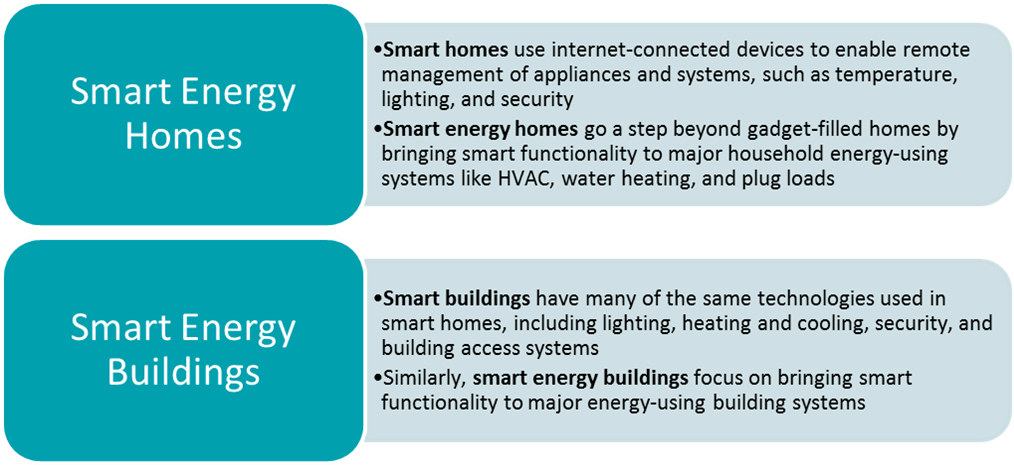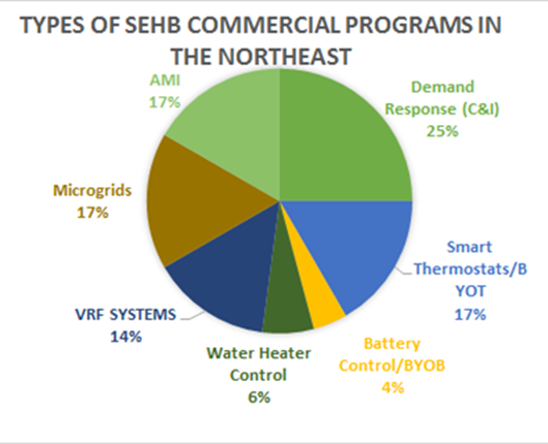

By Anonymous (not verified) | Fri, December 17, 21
This blog was co-authored by Andy Winslow, Public Policy Associate, and Bryan Evans, Residential Program Associate.
Fifteen years ago, thinking of the future inspired thoughts synonymous with anything from the Jetsons - flying cars, smart technologies throughout the home, and Rosie the robot helping with daily chores.
While we may not have cars flying around us (yet), George Jetson’s lifestyle and the many “futuristic” technologies in it have become more commonplace in 2021. We now have smart energy homes and buildings that give owners more control and comfort than ever before. You can even greet your automated robot vacuum cleaner as you make breakfast. So just how far have smart energy homes and buildings come since the Jetsons debuted in 1962? Let’s take a look.
Over the decades, smart energy building technologies such as smart meters, energy management systems (e.g. HEMS, BMS), battery storage, electric vehicles, and more have been developed and deployed. These advances were not made solely for the customer benefit and comfort. These technologies also offer key grid, energy, and climate benefits by increasing interconnectivity, control, flexibility, and resilience for the grid. As states and communities across the region continue to adopt strong decarbonization commitments, these commitments will push the boundaries on smart energy technologies. It is essential that homes and buildings across the region are not only efficient, but also flexible and able to interact with the grid to meet both grid and customer needs. This blog will highlight a few smart energy technology trends in the residential and commercial sectors.
Residential Trends
In 2015, the U.S. Department of Energy (U.S. DOE) released a Grid Modernization Multi-Year Program Plan and listed some of its main accomplishments prior to the report. At that time, the department’s work focused on the deployment of smart grid technology (smart meters, grid monitoring technologies, smart thermostats, etc.), developing technology to rapidly collect data on grid conditions, energy storage, and grid integration capabilities. Today in the Northeast, a few of these technology areas have come to the forefront, including smart thermostats and other “smart” devices, energy storage systems/batteries, and home energy management systems (HEMS) that give timely feedback to the grid. The most important drivers of technological investments and advancements are consumers and regulators, and both of these actors are pushing for a grid that is increasingly interconnected, controllable, flexible, and resilient.
As tracked and reported in NEEP’s Smart Energy Homes and Buildings Residential and Commercial Program Trackers, deployment of demand response and smart thermostat programs have led in the region. As technologies improve and adoption increases, energy savings potential and demand opportunity for things like smart thermostats grow. Across the region, demand response programs are popping up to enable utilities to offer smart thermostats through program offerings, allowing for adjustments to a resident's energy use during peak demand periods.
|
Green Mountain Power (GMP) Vermont’s largest utility is a leader in energy transformation and offers many programs and incentives including heat pump rebates, a smart control program to manage heat pumps, whole building heat pump rebates, heat pump hot water heater rebates, a battery storage program, EV rebates, and EV charging incentives. In April 2021, GMP became the first utility to offer the Span Smart Panel that replaces a home’s traditional electrical panel as an easier way for homeowners to understand and control energy use. For more information, click here |
States across the region have begun to realize the value of smart energy homes programs, technologies, and policies to help drive state decarbonization goals and grid modernization plans. For example, Efficiency Vermont, the statewide energy efficiency utility, reported in its Demand Response Capability and Effectiveness Assessment that residential demand response measures including room air-conditioning (AC) switches, heat pump water heaters, pool pump switches, and dehumidifiers can reap impactful benefits for both customer homes and the grid. Efficiency Vermont found that these four measures alone would result in more than eight MW of demand reduction (approximately $1.5 million in additional peak cost avoidance). Smart energy homes will continue to rise in popularity and importance. The region will continue to see more demand response programs and smart energy programs, policies, and technologies come to fruition.
Commercial Trends
Nearly every state in the NEEP region offers some form of program that NEEP defines as a smart energy building program for commercial buildings. The programs span from advanced meter infrastructure (AMI) to space and water heating controls and demand response. One implication of existing commercial programs is that load shifting will be very important alongside energy efficiency and renewable generation. The popularity of demand response programs and smart thermostats, as well as pilot projects in commercial battery programs, are evidence of this. Nearly every state offers demand response programs for commercial buildings. Demand response capabilities are particularly intriguing to the commercial sector as an option to lower high energy costs that may be hard to reduce with other methods.
Advanced meter infrastructure (AMI) is a growing trend in the region. Both Washington D.C. and Vermont have converted nearly all of their meters into smart meters. Advanced “smart” meters open the door for enhanced evaluation, measurement, and verification (EM&V) as well as innovative demand response programs and integrated technologies. Eight of the region's 13 jurisdictions have implemented AMI to varying degrees. Many states kicked off their AMI deployment with funds from the 2009 American Recovery and Reinvestment Act which invested over $3 billion dollars in smart grid grants.
States continue to explore the usefulness of AMI. NEEP worked with Connecticut DEEP and the Department of Energy on an advanced meter pilot in 2019 that explored new methods of quantifying energy consumption and savings in buildings with the use of near real-time energy data from advanced meters. AMI can help facilitate many other smart energy and home programs and technology, so this growth could be transformative for our region’s grid. More research, development, and public education might be needed to implement AMI in the rest of the region.
There are currently no programs in the Northeast for commercial building management systems (BMS), which integrate information about building occupancy and energy use to optimize efficiency. There are a number of barriers that exist for these systems that could explain this absence – high investment costs, software and interfaces that are difficult to navigate and interpret, software not yet being sold as a service, and lack of understanding or belief in the return on investment.
There are also only two states with commercial battery programs, as opposed to eight states that have residential battery programs. This is because the capacity of solar batteries is generally more compatible with the generation of residential solar PV units, as opposed to larger commercial units. However, as battery capacity improves to the point of handling commercial-scale distributed energy resources, this area could also grow.
Conclusion
As more states push out policies to drive smart energy home and building programs and technology advancements, the need for interconnectivity, control, flexibility, and resilience from the grid becomes greater. Through continually increasing the adoption of smart technologies, it will help control and manage the exchange between energy management solutions and the grid. NEEP continues to support the Northeast and Mid-Atlantic region’s commitment to decarbonization goals and moving towards a cleaner, flexible electric grid.


